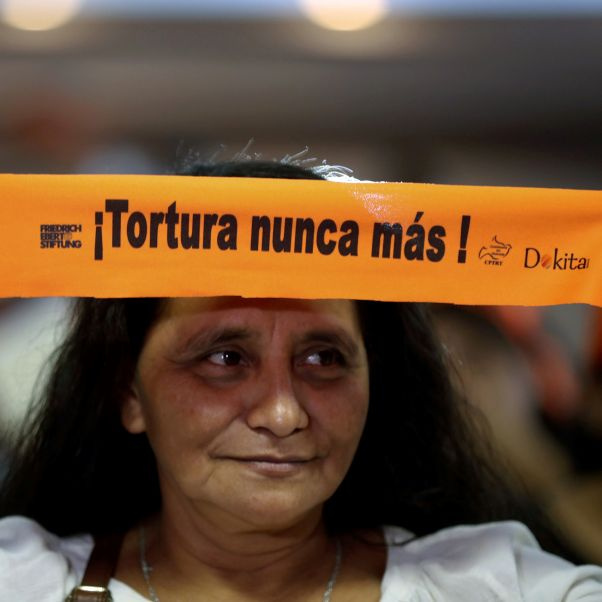Sobrescribir enlaces de ayuda a la navegación

COMMITTEE AGAINST TORTURE MEETS WITH THE SUBCOMMITTEE ON PREVENTION OF TORTURE

The Committee against Torture this morning discussed the twelfth annual report of the United Nations Subcommittee on Prevention of Torture and Other Cruel, Inhuman or Degrading Treatment or Punishment (CAT/C/66/2), with the Subcommittee’s Chair Malcom Evans.
Mr. Evans said that with the ratification by Iceland, there were now 89 States parties to the Optional Protocol and recalled that with 25 members elected for four years, the Subcommittee was the largest United Nations treaty body. Gender parity as well as the criterion of geographic representation were fully respected in its composition. During the reporting period, budget constraints had reduced the number of visits from eight to six, namely to Uruguay, Belize, Portugal, Poland, Kyrgyzstan and Liberia. Although the Subcommittee had not been able to resume its shortened visit to Rwanda that had been suspended in October 2017, it continued to maintain a rather positive relationship with the Rwandan authorities and it was possible that the visit would take place at a later date.
So far in 2019, the Subcommittee had already visited Switzerland, Costa Rica and Sri Lanka, and several members were currently visiting Senegal. Mr. Evans noted that the report contained information on the United Nations Voluntary Fund for Victims of Torture and that the Subcommittee had reviewed its approach to working with bodies such as the European Committee for the Prevention of Torture. Among other measures to ensure the effective implementation of the Optional Protocol, the Subcommittee was organizing videoconferences with national mechanisms for the prevention of torture and with representatives of States parties.
In many parts of the world, Mr. Evans said, there seemed to be a backword movement in terms of the prevention of torture. Too many States parties seemed to have resigned from their enthusiasm for the preventive enterprise by either challenging the Subcommittee’s mandate or not establishing or supporting their national preventive mechanisms under the Optional Protocol to the Convention against Torture. It was essential that all relevant bodies worked together to ensure that prevention remained a priority for States and that the “reality gap”, the gap between what was said and what was done, was addressed. The vulnerability of people in detention must be kept at the forefront of all those efforts, Mr. Evans concluded.
Committee Experts stressed the need to diagnose and identify the reasons which constrained national preventive mechanisms from functioning properly. The Experts took positive note of the number of ratifications of the Optional Protocol which had reached nearly 90 and welcomed the Subcommittee’s work with regional torture prevention mechanisms, the European Committee for the Prevention of Torture in particular, and encouraged the increased cooperation with the Committee for the Prevention of Torture in Africa as well as with the Inter-American human rights system. The Experts inquired what the Committee could do to promote the knowledge and awareness of the Subcommittee’s work in order to strengthen torture prevention and address the growing acceptance and legitimacy of torture in many countries. What was the selection process for the countries to be visited, the Experts asked, wondering whether the State’s appearance before the Committee against Torture was considered?
Jens Modvig, Committee Chairperson, noted that the Subcommittee’s assessment of the situation today concerning the prevention of torture called for a self-evaluation of the impact of the work, whether stronger tools were needed, and to identify the ways ahead.
Mr. Evans endorsed the suggestion for a structured reflection on what worked and what did not work and what could be done in addition. Both the Committee and the Subcommittee had very important tasks but there was always more that could be done to tackle torture globally in new and innovative ways. In light of the reality that the annual report outlined, the time for such a reflection might be now. With almost 90 States parties to the Optional Protocol, the Subcommittee clearly did not have the capacity to visit the States on a regular and routine basis; however, while the visits were hugely important, they were not the totality of the engagement with the States but rather a part of the process. There was more than one way of engaging with the States outside of the formal visit, Mr. Evans stressed. As far as the Subcommittee’s jurisdictional reach was concerned, it might be opportune to start issuing opinions in the form of general comments that would give greater clarity to the Optional Protocol. Mr. Evans stressed the extraterritorial reach of the Subcommittee and the national preventive mechanisms, as they had the mandate over any place where a State deprived individuals of their liberty, including outside of the State’s territory.
The sixty-sixth session of the Committee against Torture runs from 23 April to 17 May 2019. All the documents relating to the Committee’s work, including reports submitted by States parties, can be found on the session’s webpage. The webcasts of the Committee’s public meetings are available via the following link: http://webtv.un.org/meetings-events/.
The Committee will next meet in public on Thursday, 16 May at 3 p.m. to discuss follow-up to articles 19 and 22, and reprisals.
For use of the information media; not an official record
CAT/19/8E
